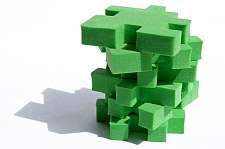Computing in the quantum dimension

A huge consortium of European researchers is solving some of the fundamental obstacles blocking real quantum computing applications in the short term. At the same time, it is helping to pave the way to a quantum computer.
It is not easy being quantum. The rules are different, often they do not seem to make sense, and as soon as you look at one thing, everything else changes. Quantum science is difficult and challenging, but that is the main reason it is so darned interesting.
Quantum mechanics led to the systematic exploitation of materials at a subatomic scale, leading to the laser, transistor and all solid-state physics such as semiconductors and microprocessors. It illuminated biology and chemistry, because it showed that mystifying, almost incomprehensible subatomic principles governed the nature of matter.
Up to now, science has exploited quantum phenomena on a macro scale - how it impacts electrons in a conducting material, for example - and to explain why materials behave in seemingly strange ways under specific conditions.
Huge consortium
But now a huge consortium of 35 European scientific and industrial actors is working together to study how to directly exploit quantum phenomena like uncertainty, entanglement and others in real-world applications. The Qubit Applications integrated project, or QAP for short, is the start of the road to quantum computing.
“We are not looking to create a quantum computer directly,” explains Professor Ian Walmsley, co-coordinator of the QAP project. “Other people are working on that, and it will take a long time to solve that problem.”
“We are, however, looking at some of the problems facing real-world quantum applications that we could deploy now.
These are problems that must be solved anyway, if a quantum computer is to become possible. Problems like the storage of information encoded on a photon.
“But by focusing on these problems, we can perhaps create important new products that could be developed in the short and medium term, and we could solve some of the fundamental problems affecting the advent of quantum computing.”
Tied up over entanglement
It is a very effective approach and, luckily, the consortium has a wide choice of topics to consider. The work is divided into five sections, looking at issues such as the storage of quantum information and transmission of certain quantum states, like entanglement, over long distances using repeaters.
Unsurprisingly, the consortium will study networks, too, and will be looking at quantum applications for simulation of extremely complex problems. “Finally, all this will need a focused dose of theory that helps frame the right questions and to understand the experimental results,” notes Walmsley.
It is an ambitious programme but QAP has the resources to make it happen. Apart from the 35 scientific and industrial partners, most of them leading authorities in their field, QAP enjoys a four-year research period and a budget of almost €13m.
An even greater resource, however, is the multidisciplinary nature of the consortium, from computer scientists and applied mathematicians to experimental physicists, as well as some very impressive industrial scientists and engineers.
Source: ICT results














